#biological exuberance
Explore tagged Tumblr posts
Text
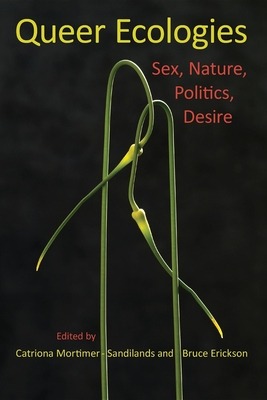

Eluding Capture: The Science, Culture, and Pleasure of “Queer” Animals by Stacy Alaimo
The chapter begins with three separate quotes—the one that speaks to me the most is by Bruce Bagemihl and his theory of Biological Exuberance where he defines it as, “above all, an affirmation of life’s vitality and infinite possibilities: a world that is at once primordial and futuristic, in which gender is kaleidoscopic, sexualities are multiple, and the categories of male and female are fluid and transmutable. A world, in short, exactly like the one we inhabit” (51).
Alaimo’s opening sentence is a powerful one, “’Nature’ and the ‘natural’ have long been waged against homosexuals, as well as women, people of color, and indigenous peoples”(51). Queer theory is guilty of trying to fully separate nature/natural from queer desire, attempting to make queer sexuality a uniquely social, human phenomenon. When the reality is that nature is awash with examples of gender and sexual diversity. The question and larger discourse ask; is nature queer? Can nonhuman nature be queer? and if so, what might that mean for other discourses?(What are the implications?) Alaimo states that we need better, ‘more robust and complex’ ways of engaging with materiality, that account for the diversity and ‘exuberance’ of a “multitude of naturecultures” (52).
Books such as Bruce Bagemihl’s Biological Exuberance: Animal Homosexuality and Natural Diversity (1999) (among many other examples) present possibilities for “radically rethinking nature as queer, by documenting the vast range of same-sex acts, same-sex childrearing pairs, intersex animals, multiple ‘genders’, ‘transvestism’ and transsexuality existing throughout the more-than-human world. Bagemihl restricts himself to mammals and birds but still manages to discuss nearly three hundred species and over 200 years of scientific research. “Bagemihl’s exhaustively researched volume renders any sense of normative heterosexuality within nature an absurd impossibility” (52).
Alaimo provides several other examples of challenges to heteronormativity in nature in recent years, including an exhibition at the Natural History Museum at the University of Oslo in Norway called, “Against Nature?” (2007). According to the website for the exhibit, “Homosexuality has been observed in most vertebrate groups, and also from insects, spiders, crustaceans, octopi and parasitic worms. The phenomenon has been reported from more than 1,500 animal species, and is well documented for 500 of them, but the real extent is probably much higher” (Against Nature 2007)(54).
The author argues that recognizing the sexual diversity of animals has several significant benefits; heteronormativity has damaged and diminished scientific knowledge (the author uses biology, anthropology as examples but I’d say this is an issue that science in general must contend with). The ‘scientific silence on homosexuality in animals amounts to a cover-up, deliberate or not’ (54) and thus scientists have a duty to correct this.
Researchers have documented how the ‘majority of scientists have ignored, refused to acknowledge, closeted, or explained away their observations of same-sex behavior in animals, for fear of risking their reputations, scholarly credibility, academic positions , or heterosexual identity” (54). Alaimo then gives examples of cases where this was the case in varying levels. As we’ve learned, the assumption of heterosexuality as the ‘only natural form’ is not an ‘appropriate benchmark for ecological research’ (54) and heteronormative bias might render already difficult work even more so.
“Endocrine disruptors alone demand an extraordinarily complex and nuanced understanding of the ‘mangling’ of environmental science, health, and politics, with misogyny, homophobia, and other cultural forces’ (55). The author recognizes that rather than simply tossing ‘queer animals into the ring of public opinion to battle the still pervasive sense that homosexuality is unnatural, we need to embrace the possibilities for the sexuality diversity of animal behavior to help us continue to transform our most basic sense of what nature and culture mean’ (55).
Alaimo’s continues by saying that biological exuberance, vast diversity ‘deviance’, and astonishing difference make nonsense of biological reductionism and the idea that animals are ‘genetically driven machines’ but creatures who exist fully within their own ‘naturecultures’ (56).
#queer ecologies: sex nature politics desire#heteronormativity#queer animals#animals#nature#biological exuberance#animal sexuality#queer ecology#ecofeminism#queer theory#critical ecology#naturecultures#reductionism#sociology
45 notes
·
View notes
Text
So I'm reading "Biological Exuberance: Animal Homosexuality and Natural Diversity" by Bruce Bagemihl.
And it's from 1999 so half of it is "yes for real homosexuality is found in nature, plz no discriminate :(" But then I got to the chapter on "Nonreproductive and Alternative Sexualities in Animals" and
Vitually every animal population includes nonbreeding individuals. There is a tendency to regard the urge to procreate among animals as instinctual, all-pervasive, and unstoppable. While heterosexual interactions often do have that quality, there are just as many examples of animals who do not reproduce: individuals who actively remove themselves from the breeding cycle...
and
Why do animals not reproduce? Biologists have coined the term reproductive suppression to refer to various forms of nonbreeding, implying that all animals would breed if they could but are somehow "prevented" from doing so. However, the underlying mechanisms involved in nonbreeding are far more complex than this name implies...animals are often "voluntary" nonbreeders...
And listen. Listen. There's another quote that I thought was referenced somwhere in this book (cannot for the life of me find which page it is on though) that's like "when animals do something we like, it's natural, and when they do something we don't like, it's animalistic." We don't need to "prove" that asexuality is biological in nature in order for asexual people to deserve rights and respects. We've gone through this dance with homosexuality and transgenderism.
But a human being is an animal, and studying other animals shapes our understanding of what it means to be one kind of animal among many. And the idea that an individual's purpose is to reproduce is pretty capitalistic, if you think about it.
The other half of this book is a list of which animals have documented homosexual behaviors, and a description of those behaviors, and even though a lot of it is "X percent of males were observed doing Y behavior, X percent of interactions were Y in nature," it really drives home that animals are complex individuals. No one wolf is going to behave exactly like another wolf, any more than any human will act exactly like another human. Maybe there is an evolutionary advantage, maybe evolution is just weird and messy, but that's how the world is. The whole argument that "if everyone were gay/asexual/engaging in nonreproductive sexualities then the species would go extinct" is technically true but that's an extremely individualistic viewpoint. As a species - as a community - there is room for so much more.
Basic biology teaches us that all animals are driven by the need to reproduce, but advanced biology once again reveals a more complex picture.
This is just a long way to say that I didn't think I needed ace affirmation in scientific literature but actually I kind of did.
24 notes
·
View notes
Text
An extraordinary form of transgendered deer occurs in some populations of White-tails. These animals, which are genetically male but actually combine characteristics of both males and females, are sometimes called VELVET-HORNS because their antlers are permanently covered with the special "velvet" skin that in most males is shed after the antlers have grown.
"Biological Exuberance: Animal Homosexuality and Natural Diversity" - Bruce Bagemihl
#book quote#biological exuberance#bruce bagemihl#nonfiction#transgender#intersex#white tailed deer#odocoileus virginianus#velvet horns#antlers
43 notes
·
View notes
Text
Often, one bird fans its left wing while the other opens its right to give a strikingly symmetrical, "mirror-image" effect, while in other cases each pair member fans the same wing in a parallel, but nonsymmetrical, pattern.

A homosexual pair of female Galahs performing a mirror-image "wing-stretching" display
"Biological Exuberance: Animal Homosexuality and Natural Diversity" - Bruce Bagemihl
#book quotes#biological exuberance#bruce bagemihl#nonfiction#galah#roseate cockatoo#eolophus roseicapillus#courtship#mirror image#wing stretching#homosexual
21 notes
·
View notes
Text
Beautifully interwoven through his discussion of this species' natural history, behavior, and preservation are evocations of the powerful spiritual role played by the Bison in Native American cultures, including descriptions of Mandan Buffalo Dances and the Lakota legend of the White Buffalo Woman.
"Biological Exuberance: Animal Homosexuality and Natural Diversity" - Bruce Bagemihl
#book quote#biological exuberance#bruce bagemihl#nonfiction#valerius geist#buffalo#american bison#bison bison#discussion#native american#lakota#white buffalo woman#natural history#animal behavior#preservation#mandan#buffalo dances
22 notes
·
View notes
Note
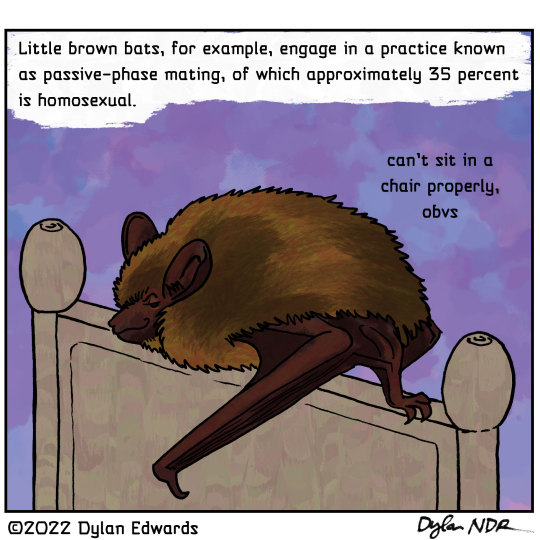
Little Brown Bats: also extremely queer
[excerpt from a comic I did for Out Front Magazine a couple of years ago about queer bats]
Favourite Bat?
Little Brown Bat!!!
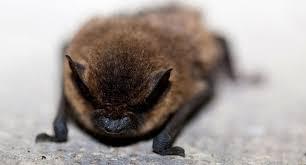
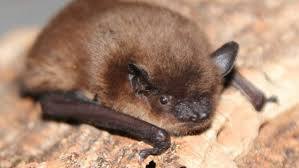
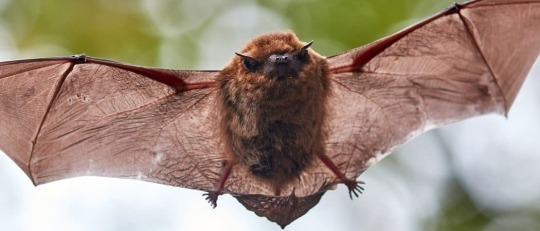
Tiny Flying Tater Tot!!!!!!!
498 notes
·
View notes
Text
I wish i still had my copy. It was amazing.
0 notes
Text
Velvet-horns usually form their own social groups of three to seven animals and live separately from both does and nontransgendered males. In fact, they are often harassed and attacked by other deer. Nontransgendered White-tails (both does and bucks of all ages, even fawns) threaten velvet-horns who try to approach them – forcing them to remain no less than ten feet away – while bucks may actively charge velvet-horns to drive them away. When threatened, velvet-horns flee without giving the standard alarm signals of other deer (stamping their feet, snorting or whistling, and raising their tails). Sometimes, groups of up to six bucks "gang up" on a velvet-horn, chasing and even violently attacking it by gashing its rump with their antlers. As a result, velvet-horns are extremely wary around other deer, venturing near feeding areas cautiously and always remaining in groups on the periphery, or else refusing to approach it at all when other deer are present.
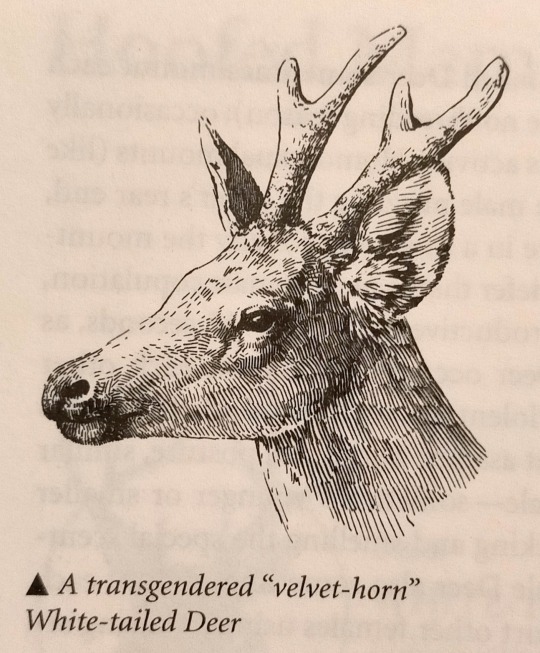
"Biological Exuberance: Animal Homosexuality and Natural Diversity" - Bruce Bagemihl
#book quote#biological exuberance#bruce bagemihl#i have so many feelings about this#life imitates art#life imitates nature#yeah me too bud i also feel like i need to stay on the periphery for my safety and wellbeing#white tailed deer#odocoileus virginianus
0 notes
Text
In European Shags, males occasionally court other males.
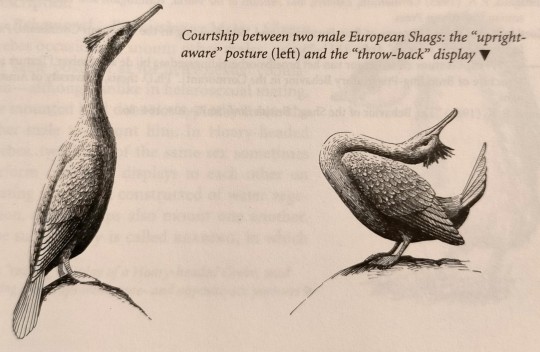
"Biological Exuberance: Animal Homosexuality and Natural Diversity" - Bruce Bagemihl
#book quotes#biological exuberance#bruce bagemihl#nonfiction#european shag#phalacrocorax aristotelis#courtship#gay#upright aware#throw back
21 notes
·
View notes
Text
White Buffalo – symbolically associated with two-spirit among the Lakota – were also regularly observed by native peoples in wild herds.
"Biological Exuberance: Animal Homosexuality and Natural Diversity" - Bruce Bagemihl
#book quote#biological exuberance#bruce bagemihl#nonfiction#white buffalo#american bison#bison bison#symbolism#two spirit#lakota
19 notes
·
View notes
Text
Same-sex pairs in many species (especially birds) raise young together. Not only are they competent parents, homosexual pairs sometimes actually exceed heterosexual ones in the number of eggs they lay, the size of their nests, or the skill and extent of their parenting.
"Biological Exuberance: Animal Homosexuality and Natural Diversity" - Bruce Bagemihl
#book quote#biological exuberance#bruce bagemihl#nonfiction#same sex#birds#homosexuality#gay#lesbian#competent#parenting#heterosexual#eggs#nests#child rearing
19 notes
·
View notes
Text
Intensive sexual encounters between male Bowhead Whales take place in shallow waters, involving three to six males at a time.

"Biological Exuberance: Animal Homosexuality and Natural Diversity" - Bruce Bagemihl
#book quotes#biological exuberance#bruce bagemihl#nonfiction#bowhead whale#balaena mysticetus#shallow water#homosexual#gay
16 notes
·
View notes
Text
On every continent, animals of the same sex seek each other out and have probably been doing so for millions of years.³
3. Homosexuality among primates, for example, has been traced back to at least the Oligocene epoch, 24-37 million years ago (based on its distribution among contemporary primates; Vasey 1995:195). Some scientists place its original appearance even earlier in the evolutionary line leading to mammals, at around 200 million years ago (Baker and Bellis 1995:5), and it has probably existed for much longer among other animal groups.
"Biological Exuberance: Animal Homosexuality and Natural Diversity" - Bruce Bagemihl
#book quote#biological exuberance#bruce bagemihl#nonfiction#homosexuality#same sex#gay#lesbian#primates#oligocene#mammals
17 notes
·
View notes
Text
Intersexed males lacking a scrotum or testes sometimes develop what are known as VELERICORN antlers, which are covered in velvet and festooned with various ridges and knobs; such antlers are permanent, unlike regular antlers, which are shed and regrown each season. Other males – sometimes known as PERUKES – have elaborate, misshapen antlers covered with baroque nodule-like growths. Occasionally, females develop antlers, which may be single; spiked (without branches); covered in velvet; or lacking the flat, palmate structure typical of male Moose antlers.
"Biological Exuberance: Animal Homosexuality and Natural Diversity" - Bruce Bagemihl
#book quote#biological exuberance#bruce bagemihl#nonfiction#moose#alces alces#intersex#velericorn#antlers#velvet#peruke
13 notes
·
View notes
Text
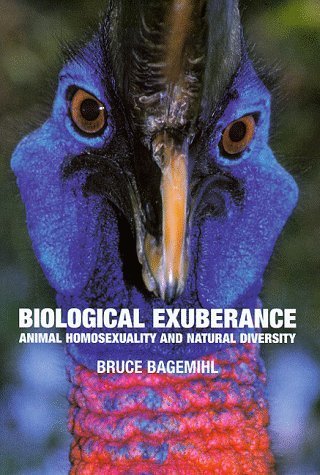
Sexuality is a social construct. Prior to the late nineteenth century, there was no concept of a homosexual identity in Western culture.
Sex were acts that were given meaning—sinful, moral transgressions. The shift from homosexual behavior as sin to a ‘crime against nature’ began during the seventeenth century (as early as 1642), where ministers in the American colonies began referring to ‘unnatural lusts of men with men, or women with women’, ‘unnatural acts’ and acts ‘against nature’ (Katz 1983, 43) (119). After the American revolution, the phrase ‘crimes against nature’ increasingly appears in the statures, implying the acts of sodomy offended a natural order rather than the will of God (D’Emilio and Freedman 1988, 122). Even ‘natural’ acts of procreation could be tainted by lust and thus were not free from sin.
Finally, sexologists at the end of the nineteenth century helped create the category of ‘sexual invert’ as an identity, where sexual inversion lied in someone’s psychology. The word ‘heterosexual’ first appeared in American medical texts in early 1890s but didn’t appear in the popular press till 1926 (Katz 1983, 16) (120).
So then queer sexualities have been seen as acts against biblical morality, against nature or against psychology=a moral problem, a physiological problem, and/or a psychological problem (Pronk 1993) (120).
The equation of natural sexual behavior = procreation is conclusively disproven by the sheer diversity of sexual practices in other species (Gaard gives a plethora of examples to support this). “If we look to nature for models of human behavior, we are bound, are we not, to value tolerance and pluralism”(Curry 1990,154)(121)…but we also must recognize that “norms for one species cannot be derived from the behaviors and seeming norms of other species” (121).
#queer history#ecofeminism#heteronormativity#animal sexuality#social construction#sociology#critical thinking#psychology#toward a queer ecofeminism#biological exuberance#diversity
3 notes
·
View notes
Text
During the breeding season, male Hooded Warblers establish and defend territories, attracting mates with whom they usually form pair-bonds.

"Biological Exuberance: Animal Homosexuality and Natural Diversity" - Bruce Bagemihl
#book quotes#biological exuberance#bruce bagemihl#nonfiction#hooded warbler#wilsonia citrina#breeding season#pair bonding
11 notes
·
View notes